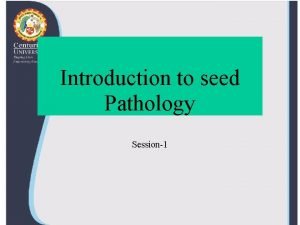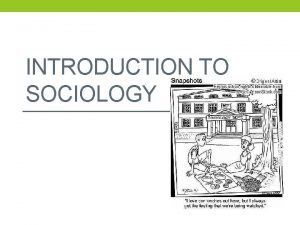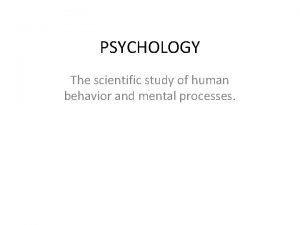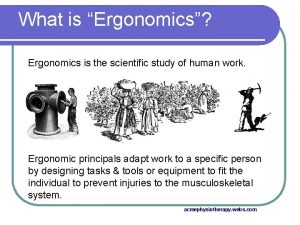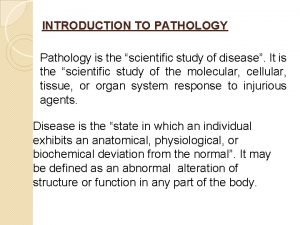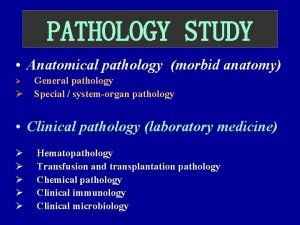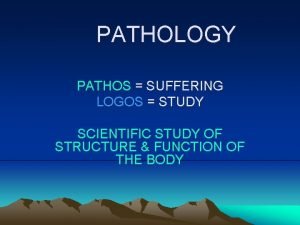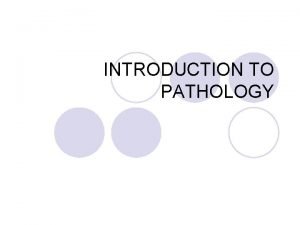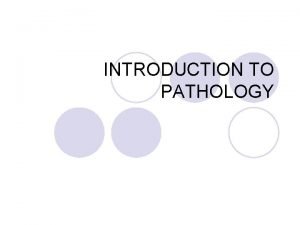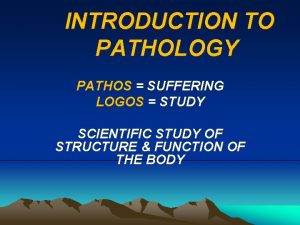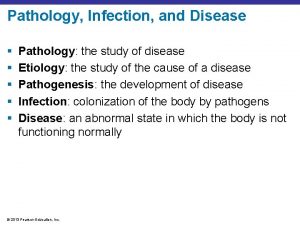INTRODUCTION TO PATHOLOGY Pathology is the scientific study














- Slides: 14

INTRODUCTION TO PATHOLOGY Pathology is the “scientific study of disease”. It is the “scientific study of the molecular, cellular, tissue, or organ system response to injurious agents. Disease is the “state in which an individual exhibits an anatomical, physiological, or biochemical deviation from the normal”. It may be defined as an abnormal alteration of structure or function in any part of the body.

Pathology focuses on 4 aspects of disease: 1. Etiology: Cause of disease. 2. Pathogenesis: Mechanisms of development of disease. 3. Morphology: The structural alterations induced in cell and tissues. 4. Functional Consequences: Functional results of the morphologic changes

Classification of Diseases Developmental – genetic, congenital. 2. Acquired: a. Inflammatory – Trauma, infections, immune, etc. b. Neoplastic – tumors cancers c. Degenerative – aging. d. Metabolic. e. Iatrogenic: Drug induced. Morbid anatomy (autopsy) (post-mortem examination) This is one of the scientific ways in pathology to study diseases. It consists of external and internal examination of the body after death. 1.

�It is through this important investigative technique of pathology that much information has been gained to help clarify the nature of many diseases. Morbid anatomy comprises both gross (naked eye) as well as microscopic examinations of the diseased organs and tissues. The post-mortem findings enable the pathologist to reach the ultimate pathological diagnosis, to make a clinicopathologic correlations and finally to deduce the cause of death. �

Microscopic and cellular pathology Pathology, and consequently medicine, was revolutionized by the application of microscopy to the study of diseased tissues that studies changes in diseased tissues at a cellular level. FIELDS OF PATHOLOGY Experimental pathology refers to the observation of the effects of manipulations on animal models or cell cultures regarding researches on human diseases. Clinical pathology is more concerned with analysis of the disease itself (etiology, pathogenesis and gross and microscopic pathology).

Subdivisions of clinical pathology Histopathology; concerned with the investigation and diagnosis of disease from gross and microscopic examination of tissues § Cytopathology; (from the examination of isolated cells) § § Hematopathology; concerned with the study of disorders affecting the cells and the coagulation system of blood. § Medical microbiology; the study of infectious diseases and the organisms responsible for them. § Immunopathology; disturbances affecting the immune defense mechanisms of the body, and their contribution to the disease processes.

• Chemical pathology; the study and diagnosis of diseases from the chemical changes that occur in tissues and fluids. • Medical genetics; the study of abnormal chromosomes and genes and their relevance to disease processes • Toxicology; study of the effects of known or suspected poisons on the body. • Forensic medicine (pathology); the applications of pathology to legal purposes (e. g. investigations of death in suspicious circumstances)

Techniques of pathology Histopathologic techniques 1. Gross pathology (macroscopic pathology) This refers to the changes affecting various organs and tissues in diseases as seen by the naked unaided eye. 2. Light microscopy Advances in light microscopic examination have resulted in a wealth of information about the structure of tissues and cells in health and disease.

� If solid tissues (e. g. liver, kidney etc. ) are to be examined by light microscopy, the sample must first be thinly sectioned to permit the transmission of light and to minimize the superimposition of tissue components. These sections are routinely cut from tissue hardened by permeation with and embedding in wax or, less often, transparent plastic. For some purposes (e. g. histochemistry, or when very urgent diagnosis is needed) sections have to be cut from tissue that has been hardened rapidly by freezing (frozen section technique). In either way, the sections are stained to help distinguishing between different components of the tissue (e. g. nuclei, cytoplasm, and other structures such as collagen)

�In addition to tissue sections, the microscope can also be used to examine cells (cytopathology) derived from � Fluid within cysts or body cavities (exfoliative cytology) � Scraped from body surfaces e. g. smears from the cervix uteri (exfoliative cytology) � Solid lesions through the use of needles (fine needle aspiration cytology). �In fact cytology is currently used widely in cancer diagnosis and screening.

3. Histochemistry Certain cells produce chemical substances the detection of which through treatment with specific reagents (stains) is of diagnostic value. 4. Immunohistochemistry and immunofluorescence These techniques employ antibodies (with antigen specificity) to visualize substances (for e. g. cellular proteins or surface receptors) in tissue sections or cytological cell preparations.

These antibodies are connected chemically to enzymes (in immunohistochemistry). Alternatively, fluorescent dyes (as in immunofluorescence) are used. Immunohistochemistry has become more popular than immunofluorescence because the latter requires a microscope modified for ultraviolet illumination and preparations are often not permanent because they fade with time.

5. Electron microscopy has extended the range of pathology to • The study of disorders at an organelle (subcellular) level. • The demonstration of viruses in tissue samples from some diseases. The most common diagnostic use of electron microscopy is the interpretation of renal biopsies i. e. helps establish the diagnosis of various glomerular diseases (glomerulopathies).

Learning pathology � General pathology, which is concerned with the causations, mechanisms and characteristics of the major categories of disease. (e. g. cell injuries and degenerations, inflammations, healing, neoplasia). � Systemic pathology is the study of various systems that comprise the body such as cardiovascular pathology, gastrointestinal pathology and so on. It includes the descriptions of specific diseases as they affect individual organs or organ systems (e. g. appendicitis, lung cancer, atherosclerosis etc, ).
 Scientific inquiry vs scientific method
Scientific inquiry vs scientific method How is a scientific law different from a scientific theory?
How is a scientific law different from a scientific theory? Introduction and importance of seed pathology
Introduction and importance of seed pathology The scientific study of language
The scientific study of language Social psychology definition psychology
Social psychology definition psychology Herbert spencer introduction
Herbert spencer introduction India baby tossing
India baby tossing The scientific study of trees
The scientific study of trees The scientific study of behavior and mental processes
The scientific study of behavior and mental processes Finished files are the result
Finished files are the result What is ergonomics
What is ergonomics The scientific study of heredity *
The scientific study of heredity * Hình ảnh bộ gõ cơ thể búng tay
Hình ảnh bộ gõ cơ thể búng tay Frameset trong html5
Frameset trong html5 Bổ thể
Bổ thể


